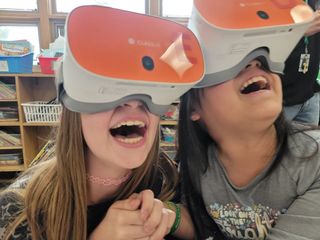The students’ faces tell the whole story.
Even with their eyes covered by virtual reality headsets, you can see laughter and expressions of joy as they participate in virtual reality experiences tailored to their classroom lessons.
“Students are just in awe of what they're seeing,” says Michael Jaber, coordinator of Instructional Technology Sheboygan Area School District in Wisconsin.
For years, much of the conversation around virtual reality (VR) in school has focused on the future potential of the technology. However, districts across the country are increasingly offering students a variety of experiences built around existing lessons.
While VR will likely improve dramatically in the future, there is a lot educators can and are doing with it right now.
Virtual Reality in Action

Jaber recently purchased a set of 32 ClassVR headsets for each of his department's three technology coaches to use with various classes. These headsets are in such demand that principals at various schools have begun looking to purchase their own sets.
Using the headsets allows for access to Avanti’s World, an educational VR theme park and other VR experiences. Students have visited the island they read about in Lord of the Flies, explored classic paintings in three dimensions, visited the moon and Mars, and flown with bees.
“It's been transformational for us,” Jaber says.
The experiences students engage in are customizable and are directly tied to classroom activities. For instance, the students who visited the Lord of the Flies island were asked to go on a scavenger hunt to find key items from the book and then discussed how the VR rendering of the island differed from the picture they had in their heads. Younger learners read Little Red Riding Hood and then tour scenes from the book.
“It changes their learning and perspective so much when they're a part of it and it's not just words on paper,” Jaber says.
Educators can also design their own custom-made VR experiences. “I took a 360 camera to one of the tech schools,” Jaber says. He went through the school’s welding area, recorded interviews, then uploaded it all so kids in a career class could take a 3D virtual tour of the facility without leaving their classroom.
Virtual Reality Best Practices
Géraldine Fauville, an assistant professor of Education Communication and Learning at the University of Gothenburg in Sweden, says educators looking to incorporate extended reality (which encompasses virtual reality and augmented reality) should ask themselves three questions:
1. What are the learning goals? “We know that XR is not appropriate for all kinds of learning goals,” says Fauville, who researches extended reality. “For example, if your goal is for students to memorize something, XR might not be what you need.”
2. Who are the learners? “You need to make sure that the hardware and application are accessible to your learners,” she says. “Is it age-appropriate, does the equipment fit in their hands, on their head?”
3. What is the context? “You don’t organize a learning activity the same way in a large classroom of high schoolers or in the library with young kids. It is important to make sure they will be safe, they won’t bump into each other or into furniture,” she says. “Moreover, you need to think about how the 10- or 20-minute long XR learning activity will fit into a larger learning context. How do you introduce the XR activity? What information do the learners need to understand before jumping in? How do you debrief after the XR learning activity? How do you continue the learning journey?”
Jaber also believes context and connecting the VR experience to the lesson is essential. “You don't want to use it as a gimmick, you want to make sure that there's educational value,” he says. “You don't want it to be a substitute, you want it to be an enhancement of what teachers are doing.”

